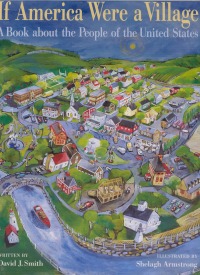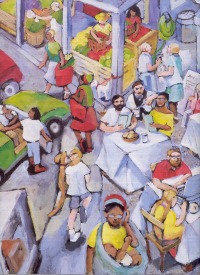| ________________
CM . . .
. Volume XVI Number 2. . . .September 11, 2009
excerpt:
Using the same premise as his first book, If the World Were a Village, author David Smith shrinks America down to a 100-person village. Each person in the village represents three million people in the real world. Smith provides information about America's population distribution along with facts about families, religions, occupations, ages, wealth, belongings, energy usage and health. In addition to discussing the present, he also focuses on the past and future, as evidenced by changing trends, one such trend being the origins of immigrants over the last hundred years. For example, in 1900, 96% of America's immigrants came from Europe; in 1950, that number was reduced to 53%, and in 2000 only 15% of immigrants were European. Another development has been the change from the majority of the population living in a rural environment to most people being city-dwellers today. Wherever possible, Smith compares life in America to life Divided into 14 chapters, all of them double-page spreads, the text also includes a table of contents as well as a list of web sites and print resources. Near the back of the book, Smith provides some tips on how parents and teachers can help their children better understand the concepts in this book. As a teaching tool, If America Were a Village delivers, but it is unlikely that most of its intended audience will pick up this book voluntarily. The illustrations, mostly rendered in primary colours, are rather juvenile, and, for the most part, do not really add much to the text.
Recommended. Gail Hamilton is a recently retired teacher-librarian in Winnipeg, MB.
To comment
on this title or this review, send mail to cm@umanitoba.ca.
Copyright © the Manitoba Library Association. Reproduction for personal
use is permitted only if this copyright notice is maintained. Any
other reproduction is prohibited without permission.
NEXT REVIEW |
TABLE OF CONTENTS FOR THIS ISSUE
- September 11, 2009.
AUTHORS |
TITLES |
MEDIA REVIEWS |
PROFILES |
BACK ISSUES |
SEARCH |
CMARCHIVE |
HOME |

 in other countries around the world in order to give readers an understanding of America's place in the global village.
in other countries around the world in order to give readers an understanding of America's place in the global village.